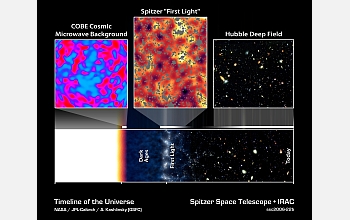Multimedia Gallery
Artist's timeline chronicling the history of the universe.
This artist's timeline chronicles the history of the universe, from its explosive beginning to its mature, present-day state.
Astronomers do not know if the very first objects were either stars or quasars. The first stars, called Population III stars (our star is a Population I star), were much bigger and brighter than any in our nearby universe, with masses about 1,000 times that of our sun. These stars first grouped together into mini-galaxies. By about a few billion years after the Big Bang, the mini-galaxies had merged to form mature galaxies, including spiral galaxies like our own Milky Way. The first quasars ultimately became the centers of powerful galaxies that are more common in the distant universe.
Credit: NASA/JPL-Caltech
Special Restrictions: Caption shortened from NASA original.
Images credited to the National Science Foundation, a federal agency, are in the public domain. The images were created by employees of the United States Government as part of their official duties or prepared by contractors as "works for hire" for NSF. You may freely use NSF-credited images and, at your discretion, credit NSF with a "Courtesy: National Science Foundation" notation.
Additional information about general usage can be found in Conditions.
Also Available:
Download the high-resolution JPG version of the image. (2.5 MB)
Use your mouse to right-click (Mac users may need to Ctrl-click) the link above and choose the option that will save the file or target to your computer.
Related story: Universe's Oldest Objects Emerge from the Background



